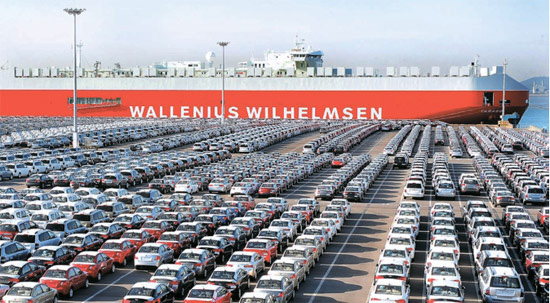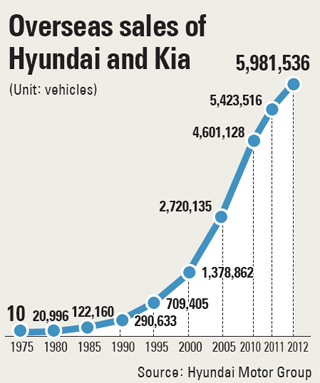Automaker closes in on a milestone

현대·기아차의 수출용 차량들이 경기 평택항에서 선적을 기다리고 있다. [사진 현대차그룹]
Thirty-eight years later, combined overseas sales of Hyundai and Kia, which fall under same umbrella of Hyundai Motor Group, are en route to surpassing 50 million vehicles sold worldwide by the end of this month.
According to the nation’s largest auto group, the accumulated overseas sales of Hyundais and Kias were 48.33 million units at the end of last year and will exceed the 50 million milestone as the companies now sell 500,000 to 600,000 units per month overseas.
“The figure has special meaning as we overcame our weak industry base from the past and business barriers from other advanced automotive countries,” the company said in release. “It also proves that Korea’s auto industry has positioned itself at the center of global auto industry.”

Hyundai Motor Group reached 10 million in overseas sales in 2001 and 20 million five years later. It reached 30 million units in 2009 and 40 million last year. As of last year, Hyundai had shipped 19.42 million vehicles to foreign countries, while its Kia affiliate exported 12.05 million.
Hyundai currently sells 19 models in 185 countries, while Kia offers 18 in 166 countries.
Korea last year produced total of 4.56 million vehicles, fifth most in the world. As other top nations like China, the United States, Japan and Germany maintain production volumes and solid domestic market bases, Korea is the only one among top five auto producing countries that exports 60 percent of its total production.
Hyundai said that establishing a global portfolio of production also has been a driver of sales. Hyundai Motor Group Chairman Chung Mong-koo has pushed to set up factories overseas since 2002 in a bid to overcome trade barriers and satisfy the tastes of local customers.
With the completion of a Brazil plant last year, the group now has production facilities in the United States (600,000 units a year), Europe (600,000), China (1.44 million), India (600,000), Turkey (100,000), Russia (200,000) and Brazil (150,000).
According to the data from Korea International Trade Association, auto exports (including parts) generated revenue of $71.8 billion last year, about 13.1 percent of the nation’s total exports. In terms of profitability, auto industry was in the black at $61.7 billion, up 5.8 percent from 2011. In contrast, the nation’s total profit from trades declined 7.5 percent year-on-year to $28.5 billion in 2012.
Hyundai hopes its strategy of increasing overseas sales of luxury models and further enhancing localization of auto parts will sustain the company’s profitability. Hyundai and Kia’s localization of auto parts stands at 90 percent, according to the automaker.
“Our achievement was done by not only us, but with the help of everyone in the industry,” an official from Hyundai said. “We just want people to know that Hyundai is putting its best effort into the continuing development of Korea’s auto industry.”
By Joo Kyung-don [kjoo@joongang.co.kr]










with the Korea JoongAng Daily
To write comments, please log in to one of the accounts.
Standards Board Policy (0/250자)